By Jeffrey A. Rendall; Photos by David Vier
DAUFUSKIE ISLAND, SC – Haig Point Club is one of those “know it when you see it” types of places.
Sometimes you just know something’s going to be great from a first glance. You see Disneyland? You know it’s going to be fun. You see the Capitol in Washington D.C.? You know it’s going to be impressive.
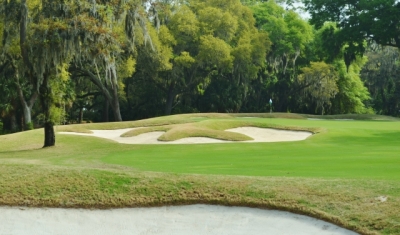 |
| Jones is renowned for incorporating the best features of the site with the golf course. No place demonstrates this better than the par five 4th hole, with a beautiful backdrop of trees. |
That was the type of feeling that Haig Point Club provided. When we saw the Rees Jones-designed masterpiece in a setting as natural and beautiful as Daufuskie Island, South Carolina, we just knew it would be hard to beat. Even the ferry ride over to the club provides a real sense of serenity – just an all-around terrific experience.
Rees Jones thought so too, and he said it was special from the get-go. “International Paper hired me to do the project, and the first thing I noticed was the maturity of the site with all those beautiful hardwood trees. We knew it was going to be a development golf course, but we wanted it to be a top 100 course – and the land we had to work with allowed us to do that. The vegetation was phenomenal.”
International Paper even used the trees that were harvested from the site – barged them off the island – because they were so valuable.
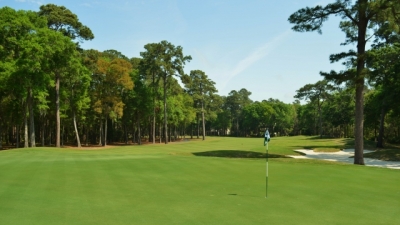 |
| The tree on the right side of the photo comes very much into play on the approach shot to the par four 12th hole. |
Haig Point is on the north end of Daufuskie Island, across the Calibogue Sound from another famous landmark of the area – Harbour Town on Hilton Head Island. Both spots are beautiful and scenic, yet Haig Point’s isolation adds privacy to the equation.
It’s a nearly perfect location for the club’s members and their guests.
The island’s history contributes to the overall quality. According to Haig Club’s Director of Golf, Jason Cherry, a man named George Haig I bought the property in 1735 from one Archibald Niele. Upon Haig I’s death in 1790, the land descended to George Haig III. Haig III subsequently sold it in 1810.
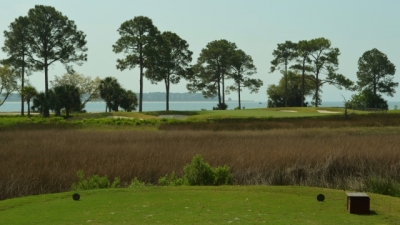 |
| Rees Jones says the 8th hole is one of the best par threes in the world. We agree. |
And although the Haigs were no longer owners, the property kept their name. Maybe if they’d known how the land would eventually be used, they wouldn’t have sold.
Oddly enough, Haig Point’s most impressive structure isn’t native to the island. The Strachan Mansion was acquired by International Paper, which had it moved from St. Simons Island (the home of Sea Island Resort) in 1986. There’s also a famous 19th century lighthouse on property, which now serves as Haig Point’s symbol and doubles as a rental property for members and wedding guests.
As for the 21st century, Haig Point Club is about golf. The club’s uniqueness is tied to its special place on the map, but also because the layout has 20 golf holes. That’s right – twenty. In addition, there are essentially two golf course set-ups, with the Calibogue course containing all the forced carries over the marsh, and the Haig Point course offering the same golf holes without the carries.
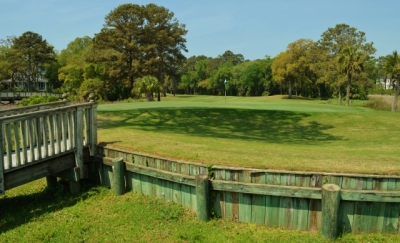 |
| It is not clear from this view, but the green of the par five 14th hole is on a narrow peninsula. Big numbers await those who miss it. |
Jones says he’s never done anything like it in any other location. “We built the two extra holes because we wanted to have a course for when people got older, or couldn’t hit it as far, or didn’t have the confidence – they’d have the Haig Point course to play. The Calibogue course is the championship course, and it can offer the types of challenges that even the best players can appreciate.”
The extra holes were necessitated by the salt marsh. The par three 8th and 17th holes both have two golf holes. The Haig Point versions are more of a “standard” par three, and the Calibogue versions demand rather lengthy carries over a marsh.
Jones is right – if you didn’t have the gentler alternatives, then many players wouldn’t even be able to play the course at all. “Because of the restrictions on entrance into the marsh area, we couldn’t build forward tees on those holes – and the carries would be too long for some players. So I almost had to build those other holes for the average player.”
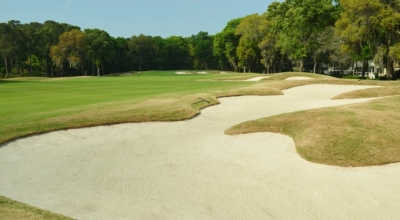 |
| At 450-yards, the dogleg left sixth hole is the longest par four on the front nine. |
Sound confusing? It really isn’t. Just follow the signs and you won’t end up in the wrong place. Trust me.
They’re also challenging golf holes, with a fresh wind coming off the Calibogue Sound. “The 8th hole is probably one of the best par threes in the world because it runs at an angle,” Jones explained. “You really need an extra club to go to the right side of the green and then the left side of the green. And it’s 68 feet deep, because that’s what the governing authorities would allow us.”
The marsh was just one of the opportunities to shape a golf hole at Haig Point. Jones said the third hole was designed completely without bunkers to emphasize the huge magnolia trees that are there. “We found those when we walked the land and moved that hole over there… I call that my ‘Gone with the Wind’ hole.”
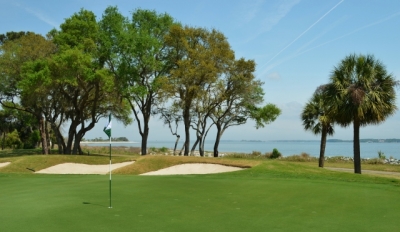 |
| The last of a world-class set of par threes -- the 17th hole. |
The third hole is certainly one you won’t forget. It isn’t everyday that you’re playing golf down a corridor containing those magnificent trees. Don’t be too surprised to see Scarlett O’Hara surveying the land… okay, maybe not.
Haig Point’s trees are hearty, too. Jones said there was a tornado that touched down during construction, taking out some of the weaker trees and leaving the par four 6th hole a good deal wider than most others on the course.
“The tornado also went down the fifth hole (par three) a little bit. Tornados often ‘jump,’ and it hit part of the first hole and the practice fairway as well. The big oak tree on the fifth hole got really hammered, but you wouldn’t know it now, all these years later,” Jones remembered.
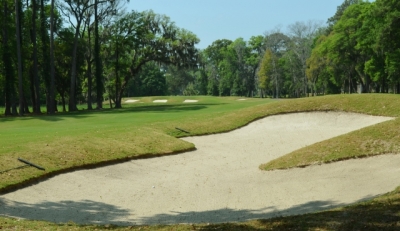 |
| The ninth hole is a par five from the Calibogue tees, and a par four from the Haig Point tees. |
Not because of tornados but because of the need to allow for better maintenance, the Jones team went in and did some renovation work in 2005. They restored the green contours that had been lost over the years and re-grassed the course as well as redoing the bunkers.
One thing they didn’t have to change was the scenery. It can’t exactly be said that scenery improves with age, but since the course opened in 1986, it’s still just as brilliant.
And the funny thing is, Jones isn’t sure that such a setting could be used today. “We had to be very careful with the quality of the water we put into the marsh on those two holes (the 8th and 17th). But for the most part, Haig Point wasn’t like a lot of the courses in the South with freshwater wetlands. We didn’t have that many buffers and they didn’t restrict us too much -- but who knows if I’d be able to build those holes now.”
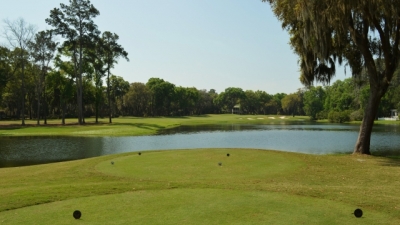 |
| The view from the tee of the par four 10th hole is.... Daunting. |
All of this, and the quality of the golf experience shouldn’t be overlooked. Haig Point is made more difficult from the somewhat narrow corridors, but it’s also an extremely fair golf course.
Jason Cherry elaborates on the challenges: “Those same trees that make the course unique and beautiful also make it more difficult. The greens are also tightly guarded by bunkers, so slightly errant shots are captured by the deep bunkers. Then you add in the swirling winds coming off the Calibogue sound and you have a recipe for a fun but challenging round.”
As alluded to above, Cherry cites the split between the Haig Point and Calibogue courses as the difference in making the golf course fair for all players. “By choosing to play the Haig tees, you eliminate the need for forced carries over hazards as well as opting for a more player-friendly yardage. I’d also say the sizes of our greens give golfers a large target to hit into on their approach shots.”
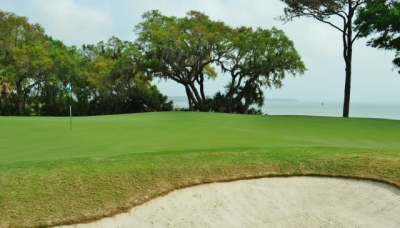 |
| The par three 5th would be a relatively unassuming hole but for the presence of Calibogue sound in back of it. |
One other aspect of the player-friendly nature of Haig Point is the lack of automobile traffic – which is rare on a golf course that’s part of a development. Now, cars don’t normally get in the way of golf, but because there are no bridges to the island, nearly everyone gets around by golf cart (or various human powered alternatives).
“With no car traffic interruptions, golfers enjoy a peaceful round amongst nature and they can play from wherever their ball ends up as we have no out of bounds at Haig Point,” Cherry commented.
If you’re fortunate enough to be invited to play at Haig Point, your full-sized four-wheeled friend will have to wait over on Hilton Head Island, but I promise you won’t miss it.
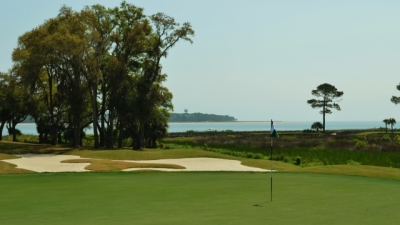 |
| The tee shot on the par three 15th hole heads back towards the land side, but you will still have to clear the marsh. |
Hole highlights certainly include the aforementioned eighth and seventeenth holes on the Calibogue course. Both are shots over the marsh with little or no bailout short. You either make it or you don’t! The seventeenth hole’s target is wider, and the tees are a little elevated – which makes it a slightly easier shot.
We also enjoyed the mammoth 615-yard, par five fourth hole. It seems to go on forever, and really makes you think of the best way to play your lay-up shot (there are a couple bunkers that squeeze the landing area). But what is perhaps most memorable about the hole is the beautiful oak backdrop – the beauty of Haig Point summed up in one scene.
The par five fourteenth is one of Jones’s favorites. “That’s been ranked by Golf Digest as one of the top 99 holes in America. We had to get an environmental okay on that because there’s a little high piece of ground between two wetlands (that’s where the green is placed). I’ve often said that’s an easy hole the first time you play it, but from then on in, you know how hard that shot is.”
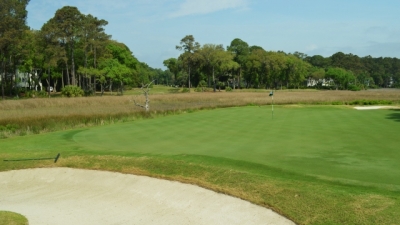 |
| The view is slightly less intimidating from the back of the green of the 8th hole. |
The green is surrounded on all sides by the marsh – and we found out how hard the hole is on the first try, when we couldn’t get a ball on the green…
The par three fifteenth hole also crosses the marsh from the back tees… but it’s shooting towards the land side. At 200-yards from the Calibogue tees, it’s a tough shot – though not quite as deadly if you’re short.
The round concludes with a 510-yard par five, reachable in two if you get a good drive.
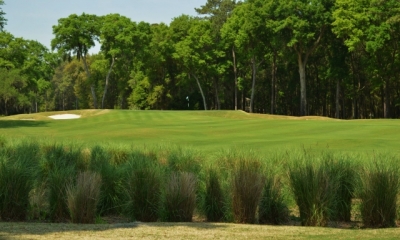 |
| The final approach shot of the day, from the fairway of the par five 18th hole. |
Also noteworthy was the club’s wonderful hospitality. The staff treated us like members and even took time to assist the non-golf playing folks in our party. Kudos to Cherry for running a very tight ship.
We could think of no better way than to have Jones sum up the Haig Point experience: “It’s just a beautiful place, and I think it’s what golf should be today – enhancing the natural beauty in an environment that you enjoy being in, and no matter how well you’re playing. It’s just a great place to be.”
Well said.
Details:
Haig Point Club
Daufuskie Island, SC
Mailing Address:
10 Haig Point Circle
PO Box 7319
Hilton Head Island, SC 29938
Phone: 843-341-8155
Website: www.haigpoint.com
Course Designer: Rees Jones
Director of Golf: Jason Cherry
Tees/Yardage/Slope/Rating
Calibogue:
Jones 7380 147/76.6
Back 6900 144/75.6
Middle 6560 139/72.2
Member 6220 133/71.5
Forward 5720 126/74.4
Haig:
Back 6735 138/74.4
Middle 6330 135/71.1
Member 5920 128/69.7
Forward 5440 124/72.9
How to play:
Haig Point is a Private member owned equity club that is accessible by being a guest of a member or sponsored by a member. The club does host members of other Private clubs by setting up a reciprocal with their home club Director of Golf to allow them access for play.
Walking is allowed.
Check the website for special event opportunities at Haig Point.
| Related Links | Comments on this article? | |
|
Maryland National Golf Club Hollow Creek Golf Club Rocky Gap Resort PB Dye Golf Club in Ijamsville Whiskey Creek Golf Club |
E-mail Jeff Rendall, Editor: jrendall@golftheunitedstates.com |












